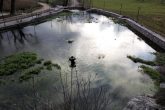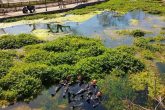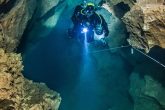Sintzi spring (Arkadia).
-

Aerial photo of Sintzi Springs in Kandila, Arkadia. -

Over the entrance of the Sintzi cave, with a south-west direction. -

Divers enjoying the nature after their diving in the Sintzi cave among the dense vegetation. -

Outside the entrance of Sintzi spring. We can clearly see the fresh water welling up from the cave. -

Outside the entrance of Sintzi spring. We can clearly see the fresh water welling up from the cave. -

The diver in the Sintzi cave. The continuous flow of the fresh water made the petrification so sharp. -

The multiforms of the Sintzi cave make it a very demanding destination. -

The areas of Sintzi cave constantly change. In many places it is very wide without being high. -

In an approximate distance of 350m from the entrance of the Sintzi cave, the divers see the bell that was used by previous missions for the decompression of the divers. -

The view of the diver some centimeters before the exit of the Sintzi cave. -

Video from Sintzi cave.
Water Springs
A water spring is a concentrated outflow of underground water that appears on the ground surface as a water current that flows freely. The springs and the streams are closely connected to the natural water circle. The rain water infiltrates underground where it is gathered in underground reservoirs and then it finds an exit to the surface through springs. The springs expand due to the water leak that happens slowly by the movement of the underground water towards the ground surface. The water leaks can create local swamps (lakes), flows (rivers) or they may be evaporated depending on the leak, the topography and the climate. In the past, their presence was significant for settlements to be created or army forces to be developed. Hydrogeologically speaking, the springs and generally the streams are actually an overflow of the water-bearing formations. This is why they usually exist at lower points, at the base level of mountain formations. Generally the springs show the water-bearing situation of an area. A large amount of small springs at a valley’s edge or at a hill’s curb is a mark of a shallow water-bearing formation with small transmittance. On the contrary, big springs in a valley’s bottom at the basic geomorphological level are a mark of a large water-bearing formation with a significant transmittance.
The history of the small town Kandila
There are references (sightseer Pafsanias) for the existence of settlements at the area since 176AD. Then, the first reference was in 1467 as “Kandila shelter” and then in 1700 on the census made by the Venetians for Peloponnese. There Kandila is mentioned as Cadilla. In 1821, Kandila had a significant role in the evolution of the revolution. ManyfighterswerefromKandila and participated in the battles. Its monastery (10th century) built at 940m in a cave dedicated to the Assumption of Virgin Mary had an important role during the revolution as it was the refuge for the Christians of the area, the center of gunpowder supply and the infirmary for the fighters. In 1699at the Orlov revolt, the monastery was set on fire and a big part of its archive was burnt. In July 19th 1826, at the gap of Kandila and the monastery the successful Battle of Kandila took place against the Turkish-Egyptian army of Ibrahim with leaders PanagiotakisNotaras and the brave Abbot Kalinikos who had also fought in other battles too. Also, TheodorosKolokotronis and his son visited the Monastery many times.
Sintzi Sprins in Arkadia
5km away from the town of Kandila, in a height of 700 meters surrounded by the ArkadianMountains and at the end of a beautiful valley of cultivable areas, there are the Springs of Sintzi. Since 1990, these springs have become a sight that draw the attention of cave divers and speleologists from Greece and abroad. There have been many important missions with the assistance of the Hellenic Speleological and Exploration Club and its divers with the milestone to be the one of 2009 when the divers reached the incredible depth of 153 meters making this cave the most deep in Greece and one of the deepest in Europe. However, the most important mission until today is the one of 2015 called “Sintzi Cave Expedition” when the diver FontasPitsinelis reached the 186 meters breaking the record of GiorgosTzavelas (153 meters) stating that the cave is even deeper. The water in the cave is fresh and the temperature is between 10-12 Celsius degrees.Generally the visibility is very good but it differentiates depending on the season and most probably on the rainfalls that change and affect the power with which the water flows out. An important detail of the morphology of the cave is its rambling area. The rocky surfaces have been carved thousands of years by the strength of the waters that gradually create the curved surface. Its grounds have solid and strong geological materials that contribute in the good visibility.
The diving
The team of Antonis Grafas, having completed at the beginnings of 2017 their education on the cave diving, considered necessary to film with the best possible way the cave of the Sintzi Springs, acknowledging its importance and wild beauty. The quite narrow cave entrance has a north-west direction and prepares the diver for the caves demands. Its narrow part has a declination of approximately 60-70 degrees and leads up to 6 meters depth where there is a quite large space where the divers can get ready. The yarn is located in a depth of 5-9 meters and leads the divers up to 350 meters where they meet the diving bell that was located there for the above mentioned missions. Over the bell, there is a hall whose roof extends over the water surface almost 4 meters. There we can see the only stalactite formations. From the point under the bell, a pit starts that leads to the deepest part of the cave. After the bell and to an opposite direction from the entrance, the diver can go to the exit from a secondary round route that leads to the first 1/3 of the initial route. This secondary route reaches the 24 meters depth in a part that the cave gets narrow as a tube of a 2-3 meters diameter.

